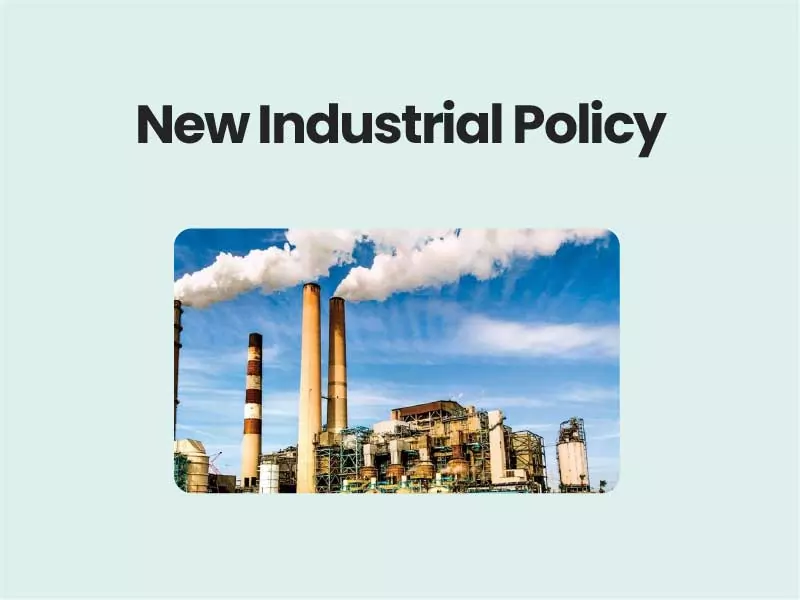Companion@360 → 7 Month programme to sharpen your writing skills → REGISTER NOW

New Industrial Policy -2018
The New Industrial Policy ( National Industrial Policy ) aims to create jobs over the next two decades, promote foreign technology transfer and attract $100 billion FDI annually.
Aim of New Industrial Policy -2018
- It subsumes the National Manufacturing Policy.
- It primarily aims at making India a manufacturing hub.
- The Department of Industrial Policy and Promotion, the nodal body for the new Policy, has floated a discussion paper inviting feedback.
- Focus groups, with members from government departments, industry associations, academia, and think tanks have been set up to look into the challenges faced by the industry.
- Six thematic focus groups include manufacturing and MSME, technology and innovation, ease of doing business, infrastructure, investment, trade and fiscal policy, skills and employability.
- Besides, a Task Force on Artificial Intelligence for India’s economic transformation has also been constituted to provide inputs for the policy.
Objectives
- It is time to shift from a policy of continuity to radical and accelerated reforms for greater strategic engagement with the world, i.e., it is time to Reform, Perform and Transform.
- A comprehensive, actionable, outcome-oriented industrial policy will enable Industry to deliver a larger role in the economy; to fulfil its role as the engine of growth and to shoulder the responsibility of adding more value and jobs.
Major concerns
- Inadequate infrastructure: Rapid growth of the economy has put further stress on infrastructure. Lack of quality industrial infrastructure has resulted in high logistics cost and has in turn affected cost competitiveness of Indian goods in global markets.
- Restrictive labour laws: The labour laws have been overly protective of the labour force in the formal sector. Though labour protection and security are required, the flipside is that it discourages employers from hiring workers on a regular basis. It has probably also led to entrepreneurs choosing to stay away from labour-intensive sectors.
- Complicated business environment: Complex and time taking business processes and clearances have been a disincentive for businesses.
- Slow technology adoption: Indian industry has been a slow adopter of new and advanced technologies. Inefficient technologies led to low productivity and higher costs adding to the disadvantage of Indian products in international markets.
- Low productivity: Workers in India are overwhelmingly employed in low productivity and low wage activities. Productivity as measured by the value-added per worker and average wages in manufacturing in India is only one-third of that in China.
- Challenges for trade: Manufacturing sector especially exporters are facing challenges of stagnant/shrinking global demand and rising protectionist tendencies around the world. Indian MSME sector is particularly facing tough competition from cheap imports from China and FTA countries.
- Inadequate expenditure on R&D and Innovation: Investments in these areas is essential to ensure growth in the industry. Public investments have been constrained and private investment is not forthcoming as these involve long gestation periods and uncertain returns.
Read Also Environment Impact Assessment
Policy proposals
It proposes to incorporate a range of measures for the following:
- Facilitating the use of smart technologies such as the internet of things (IoT), artificial intelligence (AI) and robotics for advanced manufacturing.
- Increasing the number of global Indian firms helping attract inward FDI and supporting outward FDI to assert Indian presence in world markets.
- Addressing the problem of low job creation in the formal sector.
- Enhancing industrial competitiveness
- Developing alternatives to banks and improving access to capital for MSMEs through options like the peer to peer lending and crowdfunding.
- Providing a credit rating mechanism for MSMEs.
- Addressing the problems with duty structure and also balancing it against obligations under multilateral or bilateral trade agreements.
- Studying the impact of automation on jobs and employment.
- Ensuring minimal/zero waste from industrial activities and targeting certain sectors to radically cut emissions.
- Reviewing the FDI policy to ensure that it facilitates greater technology transfer, leverages strategic linkages and innovation.
Read Also Post Mauryan Era
